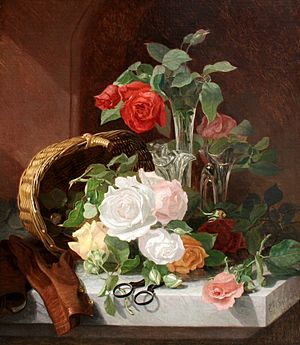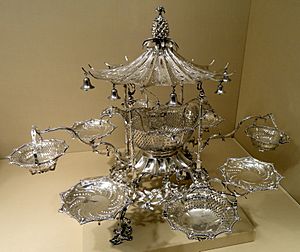Epergne facts for kids

An epergne (pronounced ih-PURN) is a special kind of decoration for the middle of a dining table. It is a fancy centerpiece that holds food or other items. Epergnes usually have a big bowl or basket in the center. From this center, several arms or branches reach out. These branches hold smaller bowls, dishes, or even candleholders.
Epergnes can have anywhere from two to seven branches. They were traditionally made from shiny silver. However, starting around the 1900s, people also began making them from beautiful glass. You can also find epergnes made from other metals or delicate porcelain.
Contents
What is an Epergne?
An epergne is more than just a decoration. It is a useful item designed to hold various things on a table. Imagine a fancy stand with many levels and arms. That is what an epergne looks like. It helps make a dining table look elegant and organized.
Parts of an Epergne
Most epergnes have a main central part. This is usually a large "bowl" or a basket. This central piece often sits on three to five feet, giving it a stable base. From this main bowl, several branches extend outwards. Each branch supports a smaller basket, dish, or even a candle holder. These smaller parts are perfect for holding different items.
Materials Used to Make Epergnes
Historically, epergnes were often crafted from silver. This made them very valuable and shiny. As time went on, other materials became popular too.
- Silver: Many older and very fancy epergnes are made of silver.
- Glass: From the early 20th century, glass epergnes became common. They often look very delicate and beautiful.
- Other Metals: Sometimes, epergnes are made from other types of metal.
- Porcelain: You can also find epergnes made from fine porcelain.
The Origin of the Name "Epergne"
The word "epergne" likely comes from the French word épargne. This French word means "saving." The idea behind the name is that an epergne "saved" dinner guests from having to pass dishes around the table. Instead, all the side dishes or treats were right there on the centerpiece.
Interestingly, in French, an epergne is actually called a surtout. The word épargne in French can also mean "spare" or "reserve." This also fits the idea of having extra dishes or items readily available on the table.
How Epergnes are Used
Epergnes are very versatile. They can be used in many different ways, both for food and for decoration.
Serving Food and Treats
In traditional dining, an epergne was a stylish way to serve various foods.
- Side Dishes: They could hold small side dishes like vegetables.
- Fruits: Fresh fruits looked lovely arranged in the different bowls.
- Sweetmeats: These were small candies or candied fruits.
- Modern Snacks: Today, you might see them holding chips, dips, or other finger foods at parties.
Decorative Uses
Beyond food, epergnes also make beautiful decorations.
- Candles: Some epergnes have candle holders on their branches.
- Flowers: They are perfect for displaying fresh flowers.
- Ornaments: During holidays, they can hold festive ornaments.
- Designer Object: Many people use epergnes simply as a beautiful object to enhance their home decor.


